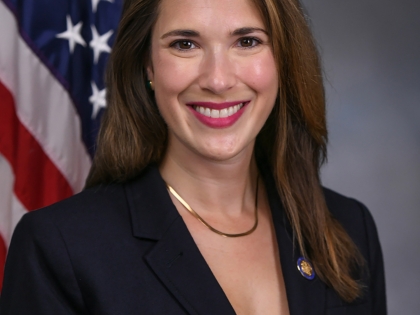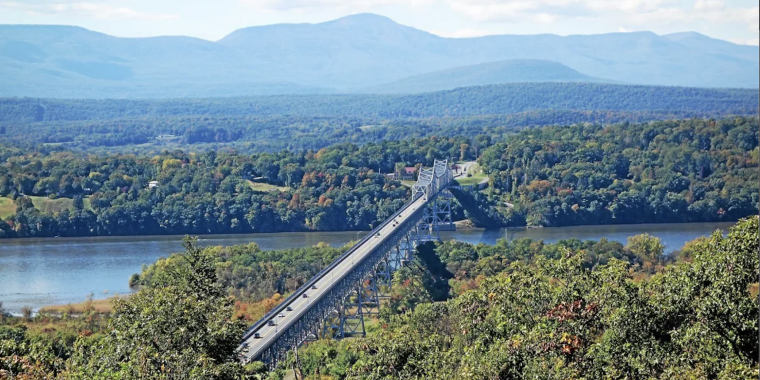
Hinchey, Rolison Lead Bipartisan Letter Calling for EPA Action on Hudson River PCB Clean-Up
March 31, 2025

Senator Michelle Hinchey speaks at a press conference with Riverkeeper in Albany, urging the EPA to oversee a full-scale cleanup of the Hudson River to protect human and environmental health in the region.
Senators Michelle Hinchey and Rob Rolison Lead 28 Senators in Urging EPA Administrator Lee Zeldin and Regional Administrator Mike Martucci to Push General Electric to Restart Hudson River Remediation Efforts
HUDSON VALLEY, NY – Senators Michelle Hinchey and Rob Rolison sent a bipartisan letter, signed by 28 of their State Senate colleagues, to EPA Administrator Lee Zeldin and Regional Administrator Mike Martucci, urging the EPA to declare that further PCB clean-up in the upper Hudson River is necessary. They’ve requested the EPA declare a ‘not protective’ determination as part of its current five-year report, including committing to a clear timeline for a full Remedial Investigation and Feasibility Study. The study would assess the full extent of PCB contamination in the lower Hudson's sediments, water, and wildlife—a portion that has been severely overlooked.
Over the course of more than 30 years, General Electric (GE) discharged more than 1.3 million pounds of Polychlorinated Biphenyls (PCBs) into the Hudson River, transforming a 200-mile stretch of the river into one of the largest Superfund sites in the nation. GE’s mandated cleanup of its pollution ended in 2015, but data consistently shows that current measures do not sufficiently protect human health and the environment, demonstrating the urgency of continued remediation.
Senator Michelle Hinchey said, “General Electric dumped toxic chemicals into our Hudson River for decades, and it’s an injustice of epic proportions that this billion-dollar corporation is still to this day allowed to sidestep responsibility. Full remediation falls squarely on the polluter, not the Hudson Valley and not our Environmental Justice communities. The EPA must mandate General Electric to immediately resume clean-up and restore the health of our Hudson River.”
Senator Rob Rolison said, “The Hudson River is the backbone of our region’s economy and environment, yet PCB contamination continues to jeopardize public health, waterfront development, and economic opportunities for our communities along the river. This isn’t just about cleanup, it’s about restoring a river that the people and businesses that rely on the river can live, work, and play in safely and every year of inaction holds back economic growth, public health, and recreational access. The EPA must step up now to ensure a full cleanup, so the Hudson can be a thriving resource for all who depend on it.”
“The scientific evidence is clear, the Hudson River PCB cleanup is failing to protect public health and the environment. Every day of inaction allows these toxic chemicals to continue harming our communities, our waters, our wildlife, and our economy,” said Tracy Brown, President of Riverkeeper. “The Hudson is a vital resource for millions of New Yorkers, yet lingering PCB 'forever chemical’ contamination continues to limit its potential. The EPA must take stronger action to address PCB pollution across the entire Superfund Site, including the Lower Hudson River and the Upper Hudson River floodplains. We stand with our state legislators in calling on the EPA to take immediate and decisive action to hold polluters accountable and restore the Hudson to a truly healthy and thriving state.”
Over the course of more than 30 years, General Electric (GE) discharged more than 1.3 million pounds of Polychlorinated Biphenyls (PCBs) into the Hudson River, transforming a 200-mile stretch of the river into one of the largest Superfund sites in the nation. GE’s mandated cleanup of its pollution ended in 2015, but data consistently shows that current measures do not sufficiently protect human health and the environment, demonstrating the urgency of continued remediation.
Senator Michelle Hinchey said, “General Electric dumped toxic chemicals into our Hudson River for decades, and it’s an injustice of epic proportions that this billion-dollar corporation is still to this day allowed to sidestep responsibility. Full remediation falls squarely on the polluter, not the Hudson Valley and not our Environmental Justice communities. The EPA must mandate General Electric to immediately resume clean-up and restore the health of our Hudson River.”
Senator Rob Rolison said, “The Hudson River is the backbone of our region’s economy and environment, yet PCB contamination continues to jeopardize public health, waterfront development, and economic opportunities for our communities along the river. This isn’t just about cleanup, it’s about restoring a river that the people and businesses that rely on the river can live, work, and play in safely and every year of inaction holds back economic growth, public health, and recreational access. The EPA must step up now to ensure a full cleanup, so the Hudson can be a thriving resource for all who depend on it.”
“The scientific evidence is clear, the Hudson River PCB cleanup is failing to protect public health and the environment. Every day of inaction allows these toxic chemicals to continue harming our communities, our waters, our wildlife, and our economy,” said Tracy Brown, President of Riverkeeper. “The Hudson is a vital resource for millions of New Yorkers, yet lingering PCB 'forever chemical’ contamination continues to limit its potential. The EPA must take stronger action to address PCB pollution across the entire Superfund Site, including the Lower Hudson River and the Upper Hudson River floodplains. We stand with our state legislators in calling on the EPA to take immediate and decisive action to hold polluters accountable and restore the Hudson to a truly healthy and thriving state.”
“Scenic Hudson thanks Senators Hinchey and Rolison for their leadership in requesting that EPA take long overdue actions at the Hudson River Superfund Site. EPA has the data it needs to acknowledge that the cleanup has failed to meet the fundamental Superfund standard: ‘protective of human health and the environment,’” said Scenic Hudson President Ned Sullivan. "We ask EPA to begin work on the addendum to the Third Five-Year Review immediately, analyze the data for 2023 and 2024, and release its decision by the end of this calendar year. At this critical juncture, EPA leadership has an important opportunity to provide long-overdue relief to the millions of people and the many businesses that rely on the Hudson River.”
The full text of the letter to EPA Administrator Zeldin and Region 2 Administrator Martucci can be found below:
March 27, 2025
Dear Administrator Zeldin and Regional Administrator Martucci,
As members of the New York State Senate, we urge the U.S. Environmental Protection Agency (EPA) to formally acknowledge that the cleanup of polychlorinated biphenyls (PCBs) in the upper Hudson River—from Hudson Falls, NY to Troy, NY—is failing to protect human health and the environment.
In January 2025, the EPA released its third five-year review report on the Hudson River PCB Superfund site (the FYR). The FYR concludes that a protectiveness determination for the upper Hudson River cleanup cannot be made until additional fish and sediment data is collected and analyzed. We strongly disagree. The EPA has ample scientific evidence to determine that the cleanup is not functioning as intended and is falling short of its original goals. As the newly-confirmed EPA Administrator—and as a fellow New Yorker—we urge you to take immediate action by issuing an addendum to the FYR that explicitly states that the cleanup is not protective of human health and the environment.
The continued presence of PCBs discharged by General Electric poses a significant and ongoing threat. These toxic compounds persist at dangerous levels throughout the Hudson River ecosystem—in soils and sediments within the river and the surrounding floodplains, in the tissues of wildlife, and in the river itself. For nearly seventy years, our constituents have borne the burden of living near a Superfund site, suffering the public health and economic consequences of PCB contamination.
The Hudson River is one of New York’s most vital natural and economic resources. From the foothills of the Adirondacks to New York Harbor, the river serves as a corridor where diverse localities, industries, and ecosystems intersect. Its scenic beauty and ecological health are essential to the prosperity of the many communities that rely on it. As state legislators, we have worked tirelessly to revitalize the Hudson Valley through legislation and budgetary investments, but those efforts are continually undermined by lingering PCB contamination.
The failure to fully remediate the Hudson River jeopardizes not only public health but also economic growth. PCB pollution deters private and public investment, stifles development, and limits recreational and commercial opportunities along the waterfront. Without decisive action, these negative impacts will persist for generations.
Additionally, long-overdue action is needed in the lower Hudson River, south of Troy. The EPA must commit to a clear schedule for conducting a Remedial Investigation and Feasibility Study (RI/FS) to assess the full extent of PCB contamination in the lower Hudson's sediments, water, and wildlife. Without this critical study, the EPA lacks the necessary data to take the next steps toward remediation. The communities along this 160-mile stretch of the river have waited nearly forty years for meaningful progress, while PCB pollution has continued to harm wildlife, decimate the fishing industry, deter economic activity, and endanger public health.
The time for delay is over. We respectfully call on the EPA to take the following urgent actions:
- Immediately initiate an addendum to the third five-year review report, recognizing that the current cleanup is not protective of human health and the environment;
- Initiate a full RI/FS for the lower Hudson River to assess contamination levels and evaluate necessary remediation measures;
- Adopt a Record of Decision for the upper Hudson River floodplain to evaluate and select cleanup approaches to address PCB contamination in the floodplain; and
- Ensure the Hudson River Superfund Office maintains its current staff to continue working towards a clean and healthy Hudson River.
These steps are critical to ensuring that the Hudson River is finally restored to a condition that protects both public health and the economic vitality of the region. We appreciate your prompt attention to this pressing matter and look forward to your leadership in advancing real solutions.
Sincerely yours,
Sincerely yours,
Senator Michelle Hinchey
41st Senate District
Senator Rob Rolison
39th Senate District
Hinchey and Rolison’s letter was signed by:
- Senator James Skoufis (D-SD42)
- Senator Monica R. Martinez (D-SD4)
- Senator Jake Ashby (R-SD43)
- Senator Chris Ryan (D-SD50)
- Senator Brad Hoylman (D-SD47)
- Senator Shelley Mayer (D-SD37)
- Senator Peter Oberacker (R-SD51)
- Senator Liz Krueger (D-SD28)
- Senator Anthony Palumbo (R-SD1)
- Senator Patricia Fahy (D-SD46)
- Senator Lea Webb (D-SD52)
- Senator Jamaal Bailey (D-SD36)
- Senator Gustavo Rivera (D-SD33)
- Senator Brian Kavanagh (D-SD27)
- Senator Samra G. Brouk (D-SD55)
- Senator Julia Salazar (D-SD18)
- Senator John Liu (D-SD16)
- Senator Andrew Gounardes (D-SD26)
- Senator Jessica Ramos (D-SD13)
- Senator Nathalia Fernandez (D-SD34)
- Senator Kristen Gonzalez (D-SD59)
- Senator April N. M. Baskin (D-SD63)
- Senator Leroy Comrie (D-SD14)
- Senator Jessica Scarcella-Spanton (D-SD23)
- Senator Toby Ann Stavisky (D-SD11)
- Senator Luis Sepulveda (D-SD32)
- Senator Roxanne J. Persaud (D-SD19)
- Senator James Sanders Jr. (D-SD10)
###
Share this Article or Press Release
Newsroom
Go to Newsroom


